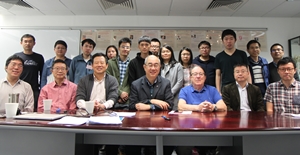Time: |
9:00am-13:10pm |
Venue: |
FSC1217, Fong Shu Chuen Building,
Ho Sin Hang Campus, Hong Kong Baptist University
(map)
|
| |
|
| Speakers: |
| Roland Glowinski, University of Houston, USA |
| Yongze Guo, Sun Yat-sen University, China |
| Felix Kwok, Hong Kong Baptist University, Hong Kong |
| Peng Li, City University of Hong Kong, Hong Kong |
| Hao Liu, Georgia Institute of Technology, USA |
| Xiangyuan Ma, Sun Yat-sen University, China |
| Qin Sheng, Baylor University, USA |
| Xue-Cheng Tai, Hong Kong Baptist University, Hong Kong |
| Tiejun Tong, Hong Kong Baptist University, Hong Kong |
|
|
| |
| Program | |
| 9:00-9:30 |
Felix Kwok
Optimized Schwarz-based Nonlinear Preconditioning for Elliptic PDEs
Abstracts: One way to accelerate the numerical solution of a nonlinear elliptic problem is to use nonlinear preconditioning, which replaces the original discretized problem by an equivalent but easier one. A well-known domain decomposition-based nonlinear preconditioner is the Additive Scwharz Preconditioned Inexact Newton (ASPIN) method, which was introduced by Cai and Keyes (2002). More recently, Dolean et al. (2016) derived the Restricted Additive Schwarz Preconditioned Exact Newton (RASPEN) method by considering the fixed point form of the nonlinear Restricted Additive Schwarz method, and showed that it compares favourably with existing methods.
In this talk, we will study the performance of a version of RASPEN that uses optimized transmission conditions. We show that a good choice of Robin parameters can lead to a significant reduction in the number of GMRES iterations required by the outer Newton loop. We motivate this choice by studying a linear model problem with discontinuous diffusion coefficients, where we show that the contraction rate can be made independent of the size of the jump in the diffusion coefficient. Numerical experiments on both linear and nonlinear problems illustrate the effectiveness of our approach.
|
9:30-10:00 |
Qin Sheng
An Experiment of Data Approximations through Feedforward Neural Networks
Abstracts: We consider an approximation of multivariate PDE data through an explicit feedforward neural network (FNN). The easy-to-follow formula provides a piecewise constant function for the data. Such a constructed FNN has two hidden layers, where the weights and thresholds are explicitly defined and do not require numerical optimization for training. The explicit FNN algorithm does not rely on any tensor structure in multiple dimensions. Instead, it automatically creates Voronoi tessellation of the domain based on the given data, and generates a reliable piecewise constant approximation of the targeted function.
These make the construction more practical for solutions of PDEs.
|
| 10:00-10:20 |
Xue-Cheng Tai
Regularized Neural Networks and Convex Shape Priori for Image Segmentation
Abstracts:
In this talk, I will present some new research work in several directions. The first part is devoted to study of deep neural networks. We propose some special techniques to add spatial regularization effects to popular deep neural networks. We use numerical experiments to show that the regularized DNN always has smooth boundary when used for image segmentation and similar classification problems. We want to emphasis that our spatial regularization effect is naturally integrated into existing deep neural networks and it only require minimal algorithmic modifications to existing neural networks. It offers very effective stability and smoothing effects into commonly used neural networks. In the last part, we will briefly mention some of recent research on convex shape representation for medical applications. This talk is based join work with different collaborators.
|
| 10:20-10:50 |
Roland Glowinski
|
| 10:50-11:10 |
Xiangyuan Ma
Automated Assessment of Risk Factors for Breast Cancer using Deep Learning Approach
Abstracts:
Breast cancer is a common cancer that can cause substantial morbidity and mortality among women. Early detection of breast cancer has a strong impact on patient survival. Breast cancer risk prediction is very important for early detection of breast cancer. Breast density is one of the strongest risk factors for breast cancer on mammogram. Fibroglandular tissue (FGT) and background parenchymal enhancement (BPE) are strong risk factors for breast cancer in breast MRI. In this talk, I will introduce our work on automated assessment of breast density on mammograms and quantitative analysis of FGT and BPE in breast MRI using deep learning approach.
|
| 11:10-11:20 |
Coffee Break |
| 11:20-11:50 |
Peng Li
Inertial Proximal ADMM for Separable Multi-block Convex Optimizations and Compressive Affine Phase Retrieval
Abstracts: Separable multi-block convex optimization problem appears in many mathematical and engineering fields. In the first part of this paper, we propose an inertial proximal ADMM to solve a linearly constrained separable multi-block convex optimization problem, and we show that the proposed inertial proximal ADMM has global convergence under mild assumptions on the regularization matrices. Affine phase retrieval arises in holography, data separation and phaseless sampling, and it is also considered as a nonhomogenous version of phase retrieval, which has received considerable attention in recent years. Inspired by convex relaxation of vector sparsity and matrix rank in compressive sensing and phase lifting in phase retrieval, in the second part of this paper, we introduce a compressive affine phase retrieval via lifting approach to connect affine phase retrieval with multi-block convex optimization, and then based on the proposed inertial proximal ADMM for multi-block convex optimization, we propose an algorithm to recover sparse real signals from their (un)corrupted affine quadratic measurements. Our numerical simulations show that the proposed algorithm has satisfactory performance for affine phase retrieval of sparse real signals.
|
| 11:50-12:10 |
Yongze Guo
Automatic Segmentation of Pectoral Muscle Based on Boundary Identification and Shape Prediction
Abstracts: The purpose of this work is to identify the pectoral muscle region in mediolateral oblique (MLO) view mammograms even when the boundary is blur or obscured. The problem is decoupled into two subproblems in our study: identifying parts of boundaries with high confidence and predicting the overall shape of the pectoral muscle. Due to the similarity in intensity and texture between pectoral muscle and gland tissue, we trained a deep neural network to distinguish them in the first subproblem. The boundary with high confidence can be obtained according to the consistency of predictions from multiple converged models. For the shape prediction problem, a generative adversarial network (GAN) is used to learn a mapping from a given identified region and the breast shape to the overall pectoral muscle shape. Our method is evaluated on a mammogram dataset including 633 MLO view mammograms collected from three different datacenters. We take U-Net as our baseline model and the dataset is divided into three groups according to the performance of U-Net for evaluation. In all three groups, U-Net achieves 80.1 %, 92.9 %, and 98.3% in Dice similarity coefficient respectively, and our method achieves 85.2 %, 94.8 %, and 98.1% in Dice similarity coefficient respectively. The experiment shows that our method effectively estimates the pectoral muscle boundary even parts of boundaries are difficult to be detected and greatly improves the performance of segmentation in this case.
We present the Convex-NonConvex (CNC) strategy which relies on the idea of constructing and then optimizing convex functionals containing nonconvex (sparsity-promoting) regularization terms thus well-known reliable convex minimization approaches can be used to compute the (unique) solution.
|
| 12:10-12:40 |
Tiejun Tong
A Pairwise Hotelling Method for Testing High-Dimensional Mean Vectors
Abstracts: For high-dimensional small sample size data, Hotelling’s T-square test is not applicable for testing mean vectors due to the singularity problem in the sample covariance matrix. To overcome the problem, there are three main approaches in the literature. Note, however, that each of the existing approaches may have serious limitations and only works well in certain situations. Inspired by this, we propose a pairwise Hotelling method for testing high-dimensional mean vectors, which, in essence, provides a good balance between the existing approaches. To effectively utilize the correlation information, we construct the new test statistics as the summation of Hotelling’s test statistics for the covariate pairs with strong correlations and the squared t statistics for the individual covariates that have little correlation with others. We further derive the asymptotic null distributions and power functions for the proposed Hotelling tests under some regularity conditions. Numerical results show that our new tests are able to control the type I error rates, and can achieve a higher statistical power compared to existing methods, especially when the covariates are highly correlated. Two real data examples are also analyzed and they both demonstrate the efficacy of our pairwise Hotelling tests.
|
| 12:40-13:10 |
Hao Liu
Learning Functions Varying along an Active Subspace
Abstracts: Many functions of interest are in a high-dimensional space but exhibit low-dimensional structures. This paper studies regression of an s-Hölder function f in RD which varies along an active subspace of dimension d while d << D. A direct approximation of f in RD with an ε accuracy requires the number of samples n in the order of ε(-(2s+D)/s). In this paper, we modify the Generalized Contour Regression (GCR) algorithm to estimate the active subspace and use piecewise polynomials for function approximation. GCR is among the best estimators for the active subspace, but its sample complexity is an open question. Our modified GCR improves the efficiency over the original GCR and leads to a mean squared estimation error of O(n(-1)) for the active subspace, when n is
sufficiently large. The mean squared regression error of f is proved to be in the order of (n/log n)-2s/(2s+d) where the exponent depends on the dimension of the active subspace d instead of the ambient space D This result demonstrates that GCR is effective in learning low-dimensional active subspaces. The convergence rate is validated through several numerical experiments.
|
|
| |
Host:
Centre for Mathematical Imaging and Vision,
Hong Kong Baptist
University
|
|

